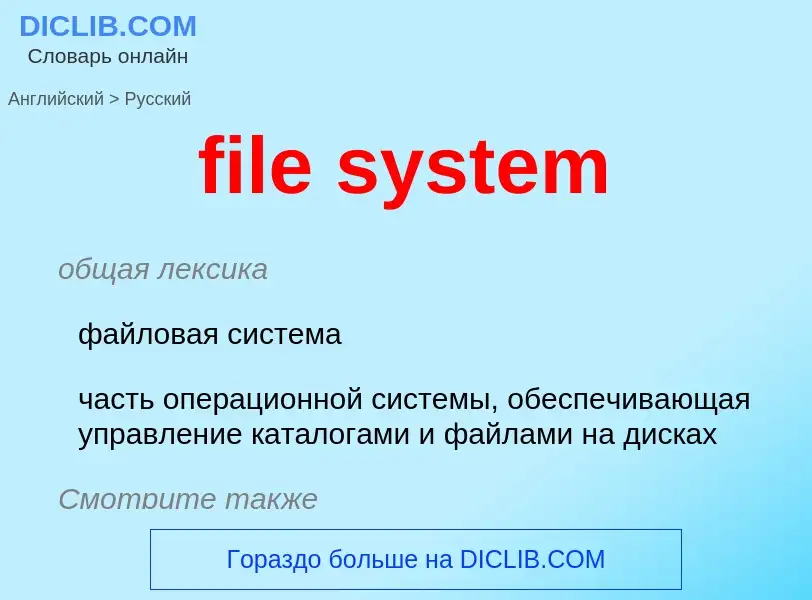Vertaling en analyse van woorden door kunstmatige intelligentie ChatGPT
Op deze pagina kunt u een gedetailleerde analyse krijgen van een woord of zin, geproduceerd met behulp van de beste kunstmatige intelligentietechnologie tot nu toe:
- hoe het woord wordt gebruikt
- gebruiksfrequentie
- het wordt vaker gebruikt in mondelinge of schriftelijke toespraken
- opties voor woordvertaling
- Gebruiksvoorbeelden (meerdere zinnen met vertaling)
- etymologie
file system - vertaling naar Engels
общая лексика
запись [элемент] каталога
содержит имя файла, время и дату его создания, атрибуты файла, номер начального кластера и другую информацию
Смотрите также
Definitie
Wikipedia
In computing, a file system or filesystem (often abbreviated to fs) is a method and data structure that the operating system uses to control how data is stored and retrieved. Without a file system, data placed in a storage medium would be one large body of data with no way to tell where one piece of data stopped and the next began, or where any piece of data was located when it was time to retrieve it. By separating the data into pieces and giving each piece a name, the data are easily isolated and identified. Taking its name from the way a paper-based data management system is named, each group of data is called a "file". The structure and logic rules used to manage the groups of data and their names is called a "file system."
There are many kinds of file systems, each with unique structure and logic, properties of speed, flexibility, security, size and more. Some file systems have been designed to be used for specific applications. For example, the ISO 9660 and UDF file systems are designed specifically for optical discs.
File systems can be used on many types of storage devices using various media. As of 2019, hard disk drives have been key storage devices and are projected to remain so for the foreseeable future. Other kinds of media that are used include SSDs, magnetic tapes, and optical discs. In some cases, such as with tmpfs, the computer's main memory (random-access memory, RAM) is used to create a temporary file system for short-term use.
Some file systems are used on local data storage devices; others provide file access via a network protocol (for example, NFS, SMB, or 9P clients). Some file systems are "virtual", meaning that the supplied "files" (called virtual files) are computed on request (such as procfs and sysfs) or are merely a mapping into a different file system used as a backing store. The file system manages access to both the content of files and the metadata about those files. It is responsible for arranging storage space; reliability, efficiency, and tuning with regard to the physical storage medium are important design considerations.

![An example of slack space, demonstrated with 4,096-[[byte]] NTFS clusters: 100,000 files, each five bytes per file, which equal to 500,000 bytes of actual data but require 409,600,000 bytes of disk space to store <!-- The size listing shown in Explorer is oddly doubly-wrong. The example files are 5 bytes each, not 0.1K, and the clusters are a minimum of 4K not 1K.--> An example of slack space, demonstrated with 4,096-[[byte]] NTFS clusters: 100,000 files, each five bytes per file, which equal to 500,000 bytes of actual data but require 409,600,000 bytes of disk space to store <!-- The size listing shown in Explorer is oddly doubly-wrong. The example files are 5 bytes each, not 0.1K, and the clusters are a minimum of 4K not 1K.-->](https://commons.wikimedia.org/wiki/Special:FilePath/100 000-files 5-bytes each -- 400 megs of slack space.png?width=200)
![Windows]] command shell Windows]] command shell](https://commons.wikimedia.org/wiki/Special:FilePath/Dir command in Windows Command Prompt.png?width=200)
![fragmented]] fragmented]]](https://commons.wikimedia.org/wiki/Special:FilePath/File system fragmentation.png?width=200)
